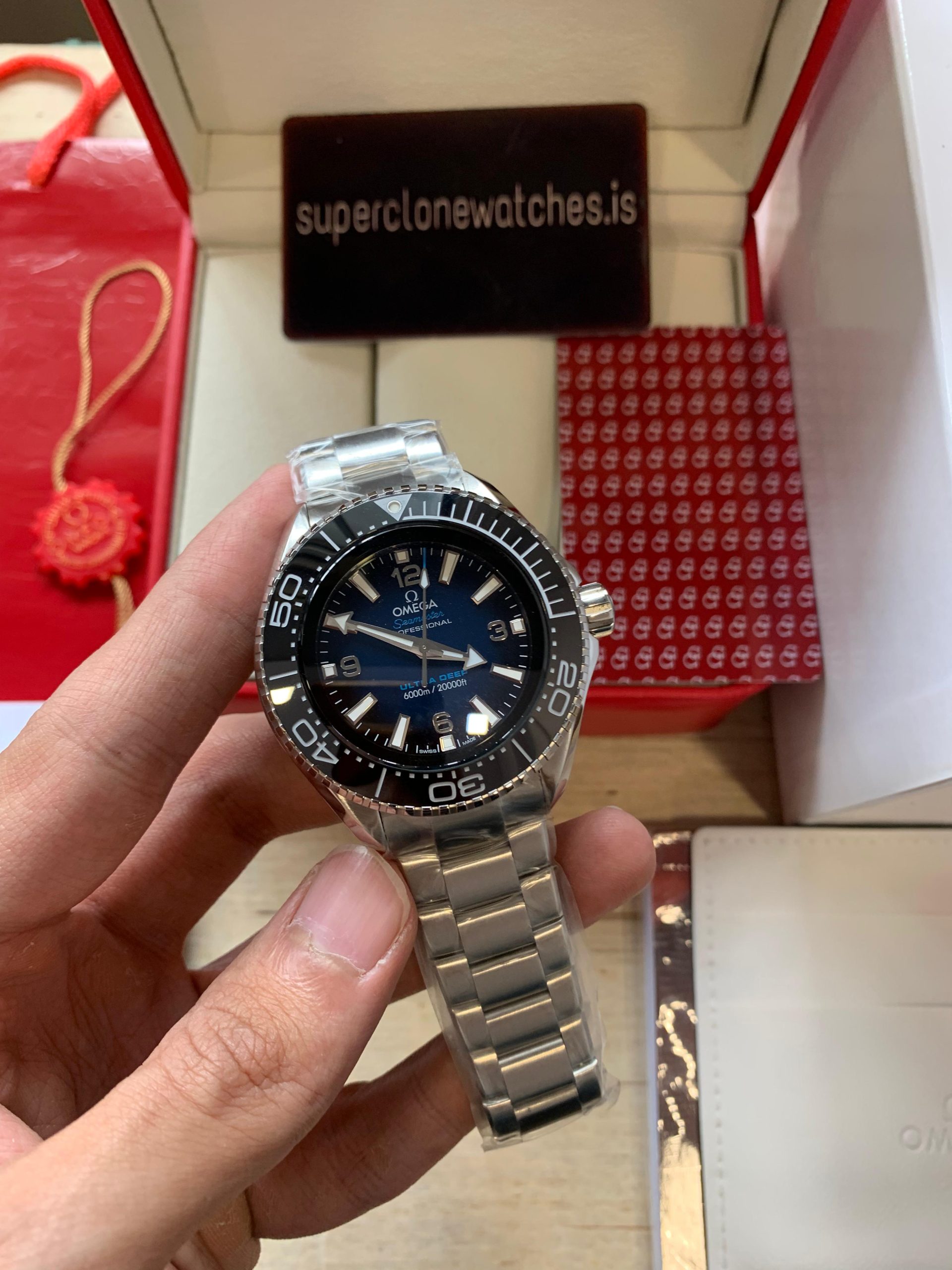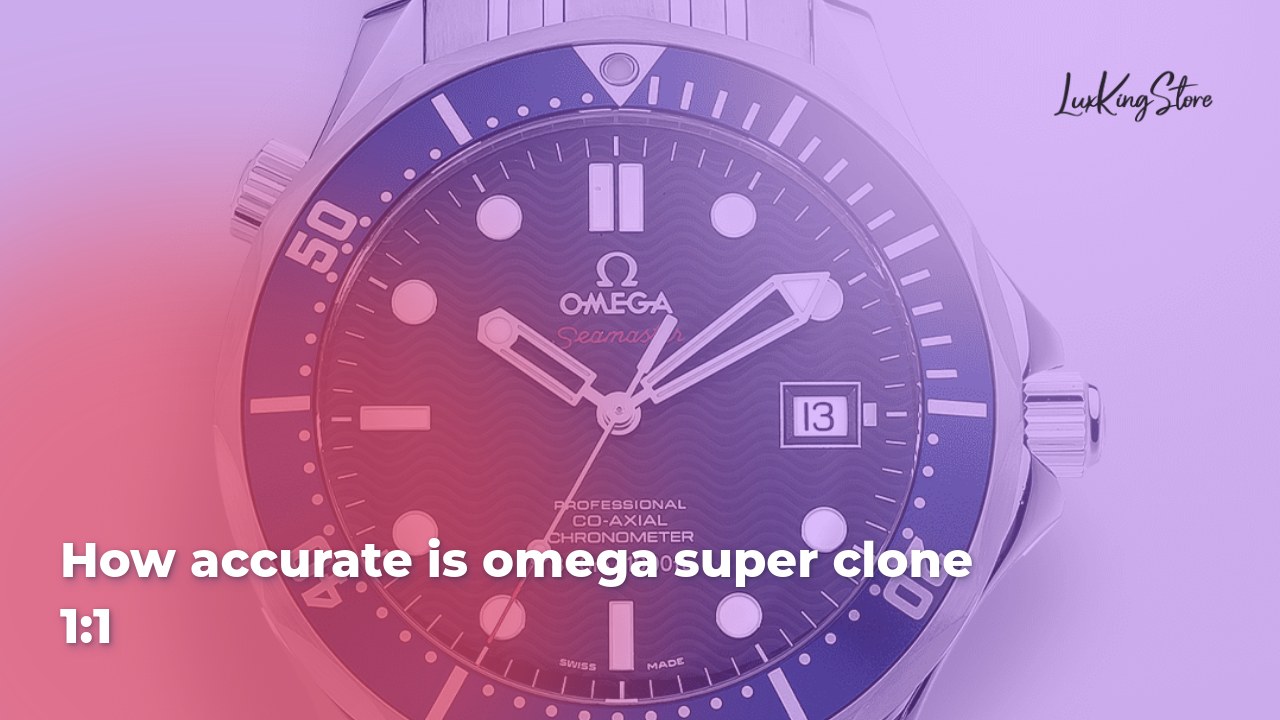How accurate is omega super clone 1:1
How Accurate is Omega Super Clone 1:1?
In the world of luxury watches, Omega stands out as a prestigious brand known for its impeccable craftsmanship and timeless designs. However, for many watch enthusiasts, the hefty price tags of authentic Omega models can be daunting. Enter the Omega Super Clone 1:1 watches a fascinating alternative that aims to replicate the original Omega timepieces in both aesthetics and functionality. But the question arises: how accurate are these clones? Are they merely imitations, or do they closely mirror the quality and precision of the originals? This exploration will dive deep into the nuances of Omega Super Clone 1:1 watches, providing a comprehensive analysis of their craftsmanship, movement accuracy, materials used, customer feedback, and their broader implications in the luxury watch market.
Understanding the Omega Super Clone 1:1 Quality
Omega Super Clone 1:1 watches are designed with a focus on closely resembling their authentic counterparts, not just visually but also in terms of mechanics. The quality of these watches depends on various factors, including the materials employed, the precision of the movements, and the overall craftsmanship behind their creation. With a dedication to detail akin to luxury manufacturing processes, Omega Super Clones aim to attract those who desire the look and feel of a high-end watch without the financial burden. This section will pave the way for an in-depth examination of the features and craftsmanship that underpin these intriguing timepieces.
Features of Omega Super Clone 1:1 Watches
Omega Super Clone 1:1 watches come equipped with several distinctive features designed to emulate their authentic counterparts. Below are some notable aspects that set these replicas apart:
- Precision Movements: Many super clones use movements engineered to function similarly to genuine Omega mechanisms. This includes Swiss clone movements that provide reliable timekeeping, often achieving an accuracy of ±3 to +5 seconds daily deviation, aligning with COSC standards.
- High-Quality Materials: Constructed from materials like high-grade stainless steel and scratch-resistant sapphire crystals, these watches ensure durability and maintain a luxurious feel. For instance, a significant number of super clones utilize 904L stainless steel, renowned for its corrosion resistance, paralleling Omega’s materials.
- Rigorous Quality Control: Premium super clones undergo stringent quality checks to ensure that every component ranging from the dial, casing, and movement meets high-quality standards. This attention to detail prevents signs of cheap materials or poor workmanship, ensuring customer satisfaction.
- Weight and Feel: Authentic Omega watches are known for their substantial weight, which many super clones mimic. A notable characteristic of superior models is the absence of any rattling, a common trait among lower-quality replicas.
- Aesthetic Accuracy: The overall design, including case shapes, summoning the exact appearance of Omega timepieces, is a primary aim for manufacturers of these clones. Customers often remark on how difficult it is to distinguish them from genuine models, even for experienced collectors.
Craftsmanship in Omega Super Clone 1:1 Production
The craftsmanship behind Omega Super Clone 1:1 watches plays a crucial role in achieving their standout quality. Several key elements characterize the meticulous production process:
- Reverse Engineering: To accurately replicate authentic Omega designs, manufacturers often reverse-engineer actual models. This strategy allows for the precise design of components using CAD/CAM technology, achieving tolerances down to 0.01mm, ensuring a perfect fit and function.
- Materials Selection: The choice of high-grade components is essential to replicating the luxurious feel of true Omega watches. Notably, besides stainless steel, ceramic materials are used, similar to those found in original offerings, creating a visual harmony with genuine timepieces.
- Automated and Manual Techniques: The combination of advanced machinery and manual techniques ensures high-quality assembly. For instance, skilled watchmakers oversee the finishing of cases and dials, ensuring that each piece meets stringent specifications.
- Attention to Detail: Craftsmanship in these replicas includes micro-engraving, precise alignment of dials and components, and an overall finish that is intended to achieve the aesthetic appeal of authentic watches.
- Testing and Quality Control: Established brands of super clones invest in extensive testing of their watches to guarantee longevity and functionality. They are often tested under various conditions to emulate how originals perform in the real world.
Comparison of Omega Super Clone 1:1 with Authentic Omega Watches
As we continue to explore the accuracy of Omega Super Clone 1:1 watches, it is vital to understand how they stack up against genuine Omega watches. The previous sections highlighted the effort made in their craftsmanship; however, several aspects require deeper scrutiny.

Differences in Materials Used
When examining the differences in materials between Omega Super Clone 1:1 and authentic Omega watches, it’s essential to consider the following points:
- Material Quality:
- Authentic Omega watches primarily utilize high-grade 904L stainless steel, which is known for its high resistance to corrosion and wear.
- On the other hand, while many super clones also pledge to use 904L material, the quality can be inconsistent, with some using inferior grades which can affect overall durability.
- Sapphire Crystals:
- Genuine Omega watches incorporate scratch-resistant sapphire crystals, offering clarity and durability.
- However, some lower-end super clones may utilize lesser-quality glass that is more prone to scratching, making it essential for buyers to verify the materials used in their replicas.
- Finishing Touches:
- Omega’s finishing techniques include intricate polishing and micro-blasting, providing a refined aesthetic.
- In contrast, certain super clones might lack these meticulous finishing touches, leading to visual discrepancies when closely examined.
- Weight Considerations:
- Authentic Omega watches are often heavier due to their superior materials and craftsmanship, reflecting their quality.
- If a super clone feels unexpectedly light, it may indicate the use of inferior materials or design components.
- Tracking Authenticity:
- Consumers must remain vigilant and reference the exact specifications of their model to ensure it meets Omega’s high standards, as some super clones may not conform to these benchmarks.
Movement Accuracy Between Super Clones and Genuine Models
One of the most critical areas of comparison between Omega Super Clone 1:1 watches and genuine Omega timepieces lies in their movement accuracy:
- Types of Movements:
- Authentic Omega models boast intricate movements like the Co-Axial escapement, known for minimizing friction and enhancing accuracy.
- In contrast, high-quality super clones may utilize their versions of automatic movements but often lack the refinement found in legitimate Omega mechanisms.
- Accuracy Ratings:
- Genuine Omega watches generally adhere to Swiss chronometer standards with minimal deviations. They are tested and certified for their precision.
- On the other hand, while super clones can achieve respectable accuracy ( ±3 to +5 seconds), they might not consistently match the performance and longevity established by authentic Omega movements.
- Mechanics and Engineering:
- The engineering behind genuine Omega watches includes innovative features that contribute to longevity. Super clones might imitate the designs but can fall short on the technical details, leading to potential reliability issues.
- Feedback and Maintenance:
- Owners of genuine Omega watches enjoy superior customer service and support, ensuring their timepieces remain in optimal condition.
- In contrast, super clone users may face challenges in sourcing parts and receiving maintenance support, affecting the long-term usability of their watches.
- Long-Term Viability:
- Authentic models are built to last and often appreciate in value over time, whereas super clones generally lack significant resale value, reflecting their inferior mechanisms and less authentic craftsmanship.
Price Comparison: Omega Super Clone 1:1 vs Authentic Omega
The financial aspect provides a substantial basis for the evaluation of Omega Super Clone 1:1 watches contrasting genuine Omega models. Let’s delve into the vibrant contrast between their respective pricing structures:
- Cost of Super Clones:
- Omega Super Clone 1:1 watches typically range from $400 to $1,500, depending on the model and seller. This price point makes them significantly more accessible to a broader demographic.
- Authentic Omega Pricing:
- In stark contrast, genuine Omega watches usually start around $5,000 and can escalate into tens of thousands for iconic or limited-edition models. This price disparity often puts authentic pieces out of reach for many enthusiasts.
- Value Retention:
- Authentic Omega watches are viewed as investment pieces a rarity often appreciates in value over time.
- Conversely, Omega Super Clone 1:1 watches do not hold significant resale value. This fact is essential for collectors as counterfeit luxury items typically depreciate rapidly.
- Consumer Perceptions:
- While super clones provide financial relief for many watch lovers, they raise questions about the authenticity and prestige associated with owning a luxury watch. In this vein, prospective buyers should consider what they prioritize: the look or the legacy that an authentic Omega brings.
- Market Segment:
- Many watch collectors appreciate super clones for their aesthetic similarities, yet the tangible difference in names carries weight, impacting future transactions.
Customer Reviews and Experiences with Omega Super Clone 1:1
Consumer feedback is vital in gauging the popularity and credibility of Omega Super Clone 1:1 watches. Many users share mixed feelings that reflect their diverse experiences:

Common Praise for Omega Super Clone 1:1
Positive reviews largely center around the high standards many Super Clone 1:1 watches achieve. Here are some recurring themes of praise:
- Visual Appeal:
- Many customers highlight the stunning aesthetics of these clones. Reports suggest that even experienced watch enthusiasts often have a difficult time identifying super clones compared to original pieces.
- Quality of Craftsmanship:
- User feedback often praises the impeccable craftsmanship and detail invested in creating super clones. Users report feeling a premium experience, likening it to that of luxury watches without the exorbitant price tag.
- Mechanical Performance:
- Several reviews praise the reliable timekeeping capabilities of these replicas. Buyers consistently note that premium models often achieve accuracy results close to those of authentic pieces, which is commendable for the price point.
- Comfort:
- Customers frequently mention the comfort factor, stating that the weight and grip of these watches feel genuine, further contributing to the overall enjoyment of wearing them.
- Value-for-Money:
- Given the stark price comparison to actual Omega watches, many customers feel satisfied with their purchase, emphasizing they receive satisfactory quality without breaking the bank.
Common Criticisms of Omega Super Clone 1:1
Despite the positive feedback, some criticisms are prevalent among consumers evaluating their super clone experiences:
- Durability Concerns:
- Some users express concerns regarding the long-term durability of these watches, suggesting that while they may look great initially, the performance may decline faster than that of authentic models.
- Movement Reliability:
- A number of customers noted discrepancies in the inner workings of the watch. Issues with the movement often emerge after prolonged usage, leading to concerns about the mechanical longevity of super clones.
- Purchase Risks:
- Since the market for super clones is rife with counterfeit offerings, buyers have raised alerts about purchasing from unreliable sellers, thus emphasizing the importance of verifying the source of their watch.
- Limited Service Support:
- Unlike authentic brands, super clones typically lack a structured customer support system, which can make maintenance and repair challenging when issues arise.
- Identity Issues:
- Some buyers reported feelings of dissatisfaction regarding identity, suggesting a disconnect between owning a replica versus an authentic piece. The prestige of brand associated with luxury watches resonates heavily among enthusiasts.
Authenticity Verification Methods for Omega Super Clone 1:1
As customers express concerns about discerning authenticity, understanding verification methods for Omega Super Clone 1:1 watches becomes vital when assessing their purchase:
Visual Inspection Techniques
Engaging in visual inspections can significantly help consumers distinguish between authentic and super clone models. Here are practical techniques:
- Serial Number Examination:
- Each genuine Omega watch features a uniquely engraved serial number on its case back. Super clones may lack the precision and clarity in this detailing, making examination essential.
- Logo Inspection:
- Examine the Omega logo for precise crafting. Genuine models display perfect font consistency and spacing, while subpar replicas may show inconsistencies in design.
- Movement Verification:
- If possible, inspect the watch movement through a transparent case back to verify if it reflects authentic markings. High-quality Omega movements are known for their craftsmanship, and their super clones often fall short in this area.
- Overall Build Quality:
- A tangible examination of weight, materials, and finishes can reveal discrepancies. Authentic Omega watches possess a substantial weight and flawless finish, while super clones may exhibit inferior craftsmanship.
- Documentation Reference:
- Always cross-check the watch against relevant documentation, including the original box and warranty card to ensure all details align accurately.
Mechanisms for Testing Movement Accuracy
Assessing movement accuracy is essential when differentiating between Omega Super Clone 1:1 watches and their authentic counterparts. Here are methods to evaluate their performance:
- Sweep Rate Analysis:
- You can conduct a simple sweep rate test to ensure the second hand moves fluidly without any stepping motion, which indicates quartz rather than automatic mechanism fidelity.
- Materials Assessment:
- Evaluation of the materials used hinge on the internal workings of the watch. Authentic Omega uses premium materials that contribute to a satisfying weight; anything lighter may suggest inferior construction.
- Dial Inspection:
- Inspecting the dial markings is crucial. Authentic dials exhibit clarity, high precision, and crisp lettering. Discrepancies in printing may indicate a lesser-quality replica.
- Detailed Examination of Engravings:
- Look for subtle engravings on the case back. These markings should match those of the original models, as discrepancies can be telltale signs of a counterfeit piece.
- Accuracy Testing:
- A simple timekeeping test allows for a gauge of accuracy over a 24-hour cycle to see if it meets the expected standards. While genuine pieces adhere to COSC precision, super clones may falter.
Implications of Purchasing Omega Super Clone 1:1
The decision to purchase Omega Super Clone 1:1 watches carries various implications for consumers, particularly influencing their experiences and perceptions within the luxury market:
Impact on Luxury Market Perception
The rise of Omega Super Clone 1:1 models has generated significant tremors in the luxury watch market:
- Accessibility:
- Offering a more affordable alternative, super clones cater to consumers who crave the elegance of high-end watches without the hefty price tag. This democratization of luxury can shift consumer behavior.
- Brand Dilution Concerns:
- As super clones gain traction, luxury brands like Omega face the risk of diminished exclusivity and prestige, as consumers may attribute less value to the authentic pieces.
- Changing Consumer Relationships:
- Watch lovers are recalibrating their relationships with brands like Omega. For many, the status associated with luxury pieces outweighs their financial implications, prompting an interest in aesthetics over authenticity.
- Market Dynamics Shift:
- The growing popularity of super clones compels luxury brands to adapt pricing strategies, reflecting changing consumer attitudes. This evolution may lead to an adjustment of how luxury watches are marketed and perceived.
- Quality versus Brand Value:
- Consumers must contend with the dilemma of perceived quality in super clones versus the input value of authentic items, navigating their individual choices amidst a shifting paradigm.
Frequently Asked Questions (FAQs)
- What distinguishes Omega Super Clone 1:1 watches from genuine Omega timepieces?
- Omega Super Clone 1:1 watches are designed to imitate genuine Omega models closely but may use inferior materials and less precise movements. Authentic Omega pieces are backed by superior craftsmanship and brand prestige.
- Are Omega Super Clone 1:1 watches reliable?
- Many high-quality super clones offer reliable performance; however, the longevity and accuracy may not consistently match those of genuine Omega watches.
- Can super clones appreciate in value?
- Typically, super clones lack significant resale value, as they are regarded as replicas rather than collectibles like genuine luxury watches that can appreciate over time.
- How can I authenticate an Omega watch?
- Authenticating an Omega involves examining serial numbers, logos, movement quality, and build materials, while also ensuring the watch matches its documentation.
- What are the advantages of purchasing a super clone?
- The primary advantage of super clones is affordability, allowing consumers to enjoy the aesthetics of luxury watches without the financial burden of purchasing an original.
Key Takeaways
- Omega Super Clone 1:1 watches are designed to replicate the aesthetics of genuine Omega timepieces while being more affordable.
- Quality craftsmanship and attention to detail can vary significantly between brands of super clones.
- Movement accuracy is an essential factor, with super clones often falling short of the performance benchmarks set by authentic Omega watches.
- Consumer reviews indicate a mix of satisfaction and concern regarding durability and maintenance of super clones.
- The rise of replicas impacts luxury brands’ exclusivity and market perceptions, leading to changing consumer attitudes.
Conclusion
Omega Super Clone 1:1 watches represent a fascinating intersection of luxury aesthetics and accessibility, appealing to a wide range of consumers. While they offer an enticing alternative for those who desire the elegance of Omega timepieces without the steep price, potential buyers should remain mindful of the inherent limitations in craftsmanship and movement accuracy. As the market continues to evolve, the implications of owning a super clone versus an authentic luxury watch prompt an ongoing dialogue about authenticity, value, and consumer preferences. Ultimately, individuals must assess their motivations for purchasing, weighing the allure of luxury against the tangible benefits that accompany genuine heritage and craftsmanship.
Suggested Google Search Keywords:
- Omega super clone 1:1 review
- are omega super clones worth it?
- differences between omega super clone and authentic
- movement accuracy of omega watches
- best omega super clones on the market

